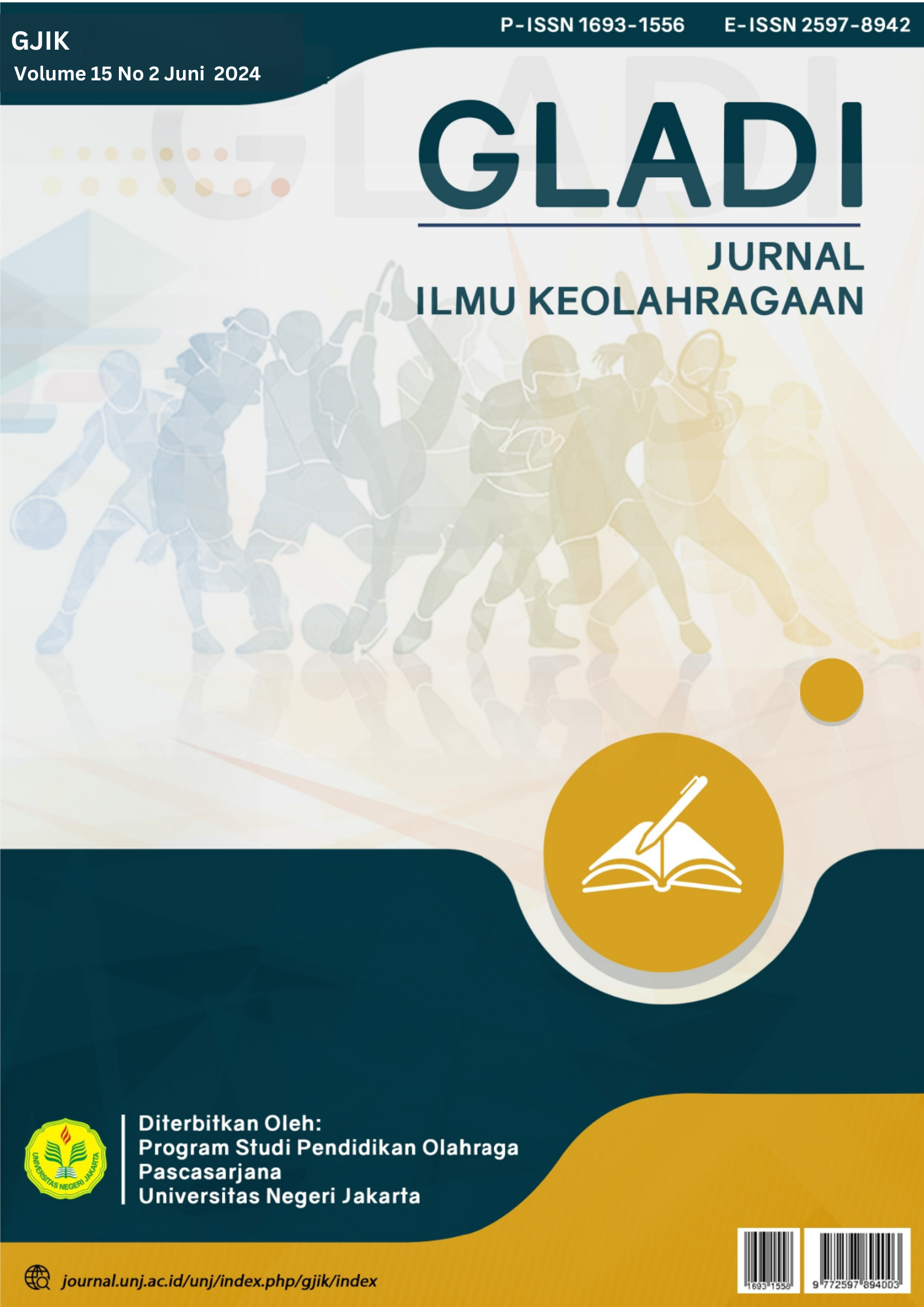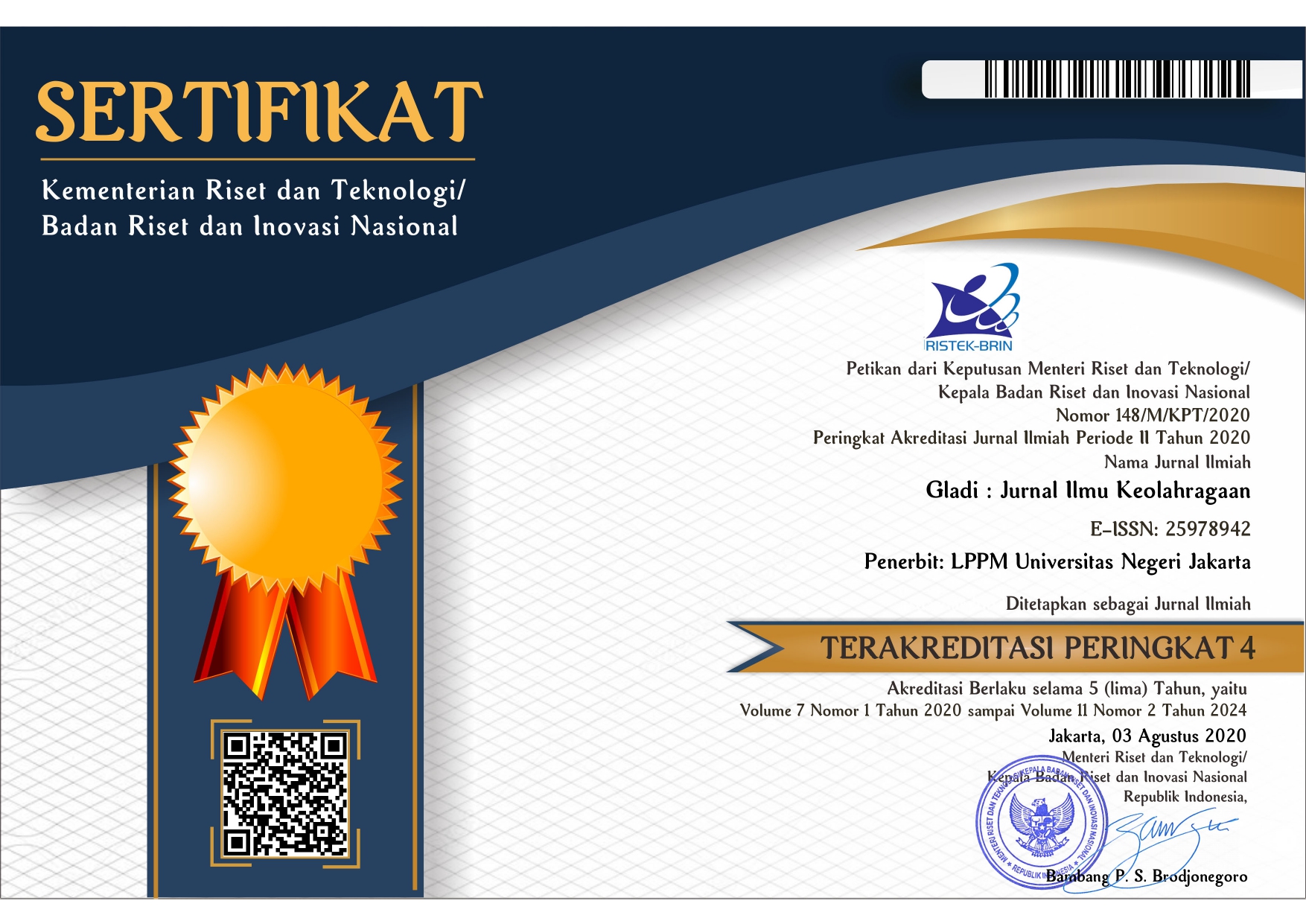Analysis of Maximum Squat Ability in Futsal Players Who Have a History of Leg Injuries
Abstract
A person's maximum squatting ability can be known using biomechanical analysis. Biomechanical analysis is also a form of injury prevention. For futsal players, squats are one of the exercises used to determine the strength of the leg muscles. The aim of this study was to analyze the maximum squatting ability of futsal players who have a history of leg injuries. This research uses quantitative descriptive research by analyzing kinematic principles in biomechanics using kinovea 0.9.5 software. A purposive sampling technique was used in this research to determine the research sample, which consisted of 9 male athletes with a history of leg injuries. The results obtained in this study in the eccentric phase of the squat movement resulted in an average body tilt angle of 63.16 ± 9.58 degrees and a knee angle of 49.1 ± 10.61 degrees. The tilt angle of a normal person's body position during a deep squat or maximum squat position is 52.6 degrees. The knee angle during the maximum squat movement is 120-140 degrees and the squat position at full depth is 115-125 degrees. The limitation of this research is that the motion analysis was not carried out in 3 dimensions, so horizontal and frontal motion could not be analyzed.
Downloads
References
Butler, R. J., Plisky, P. J., Southers, C., Scoma, C., & Kiesel, K. B. (2010). Biomechanical analysis of the different classifications of the functional movement screen deep squat test. Sports Biomechanics, 9(4), 270–279. https://doi.org/10.1080/14763141.2010.539623
Comfort, P., & Kasim, P. (2007). Optimizing Squat Technique. Strength and Conditioning Journal, 29(6), 10–13. https://doi.org/10.1519/00126548-200712000-00001
Daniel Richter. (2023, December). Squat Depth: How Deep Should You Squat. StrengthLog. https://www.strengthlog.com/squat-depth-how-deep-should-you-squat/#:~:text=Deep squats %28120–140° knee flexion%29 lead to greater,greater carryover to shallow squats than vice versa
Diggin, D., Regan, C. O., Whelan, N., Daly, S., Mcloughlin, V., Mcnamara, L., & Reilly, A. (2011). A biomechanical analysis of front versus back squat: injury implications. Journal of Sport Sciences, 11(2001), 643–646. http://www.researchgate.net/publication/258363730_A_biomechanical_Analysis_of_front_and_back_squat_injury_implications/file/e0b49528105693baa7.pdf
Endo, Y., Miura, M., & Sakamoto, M. (2020). The relationship between the deep squat movement and the hip, knee and ankle range of motion and muscle strength. Journal of Physical Therapy Science, 32(6), 391–394. https://doi.org/10.1589/jpts.32.391
Escamilla, R. F., Fleisig, G. S., Lowry, T. M., Barrentine, S. W., & Andrews, J. R. (2001). A three-dimensional biomechanical analysis of the squat during varying stance widths. Medicine and Science in Sports and Exercise, 33(6), 984–998. https://doi.org/10.1097/00005768-200106000-00019
Gawda, P., Zawadka, M., Paszkowska, M. S., Smolka, J., & Lukasik, E. (2017). Biomechanics Of The Squat In Rehabilitation and Sports Training. Polish J Sport Med, 33(2), 87–96. https://doi.org/10.5604/01.3001.0010.2294
Hendriadi, R. (2019). Pengaruh Latihan Squat Barbel dan Squat Resistance Band Terhadap Peningkatan Power Tungkai Pemain Sepakbola U-15 Tahun di SSB Baturetno. E-JOURNAL UNY.
Horschig, A. (2020). Squat Form For Your Anatomy [Perfect Depth Stance And Width].
Irawan, F. A., & Long-Ren, C. (2015). Comprehensive Pitching Biomechanics and Injury Prevention for Young Baseball Pitchers-A review. Journal of Physical Education and Sport Science, 21(January), 11–21. https://doi.org/10.6634/JPSS-CCU.201512.21.02
Macrum, E., Bell, D. R., Boling, M., Lewek, M., & Padua, D. (2012). Effect of limiting ankle-dorsiflexion range of motion on lower extremity kinematics and muscle-activation patterns during a squat. Journal of Sport Rehabilitation, 21(2), 144–150.
Mansur, L. K., Irianto, J. P., & Mansur, M. (2018). Pengaruh Latihan Squat Menggunakan Free Weight dan Gym Machine Terhadap Kekuatan, Power, dan Hypertrophy Otot. Jurnal Keolahragaan, 6(2), 150–161. https://doi.org/10.21831/jk.v6i2.16516
Narlan, A., Juniar, D. T., & Millah, H. (2017). Pengembangan Instrumen Keterampilan Olahraga Futsal. Jurnal Sili, 3(2), 241–247.
Prastiwi, T. A. S., & Irawan, F. A. (2022). Tinjauan aspek biomekanika tembakan tiga angka pada permainan bola basket Overview of the biomechanics of three-point shots in basketball. Altius: Jurnal Ilmu Olahraga Dan Kesehatan, 11(1), 1–10.
Rachman, A. (2021). PENGARUH LATIHAN SQUAT DAN LEG PRESS TERHADAP STRENGTH DAN HYPERTROPHY OTO TUNGKAI. Jurnal Multilateral, 13(2), 89–102.
Schoenfeld, B. J. (2010). Squatting Kinematics and Kinetics and Their Application to Exercise Performance. Journal of Strength and Conditioning Research, 24(12), 3497–3506.
Soendari, T. (2012). METODE PENELITIAN DESKRIPTIF.
Syafaruddin. (2018). TINJAUAN OLAHRAGA FUTSAL. Altius: Jurnal Ilmu Olahraga Dan Kesehatan, 7.
Zawadka, M., Smolka, J., Skublewska-Paszkowska, M., Lukasik, E., & Gawda, P. (2020). How are squat timing and kinematics in the sagittal plane related to squat depth? Journal of Sports Science and Medicine, 19(3), 500–507.
Copyright (c) 2024 Ulfatul Azizah Awaliyyah, Fajar Awang Irawan

This work is licensed under a Creative Commons Attribution-ShareAlike 4.0 International License.







